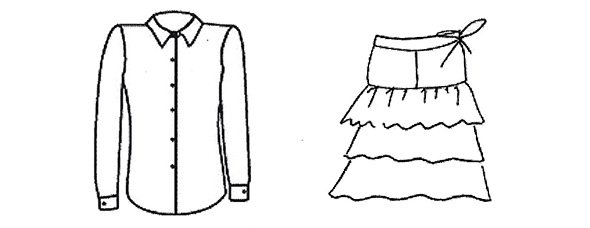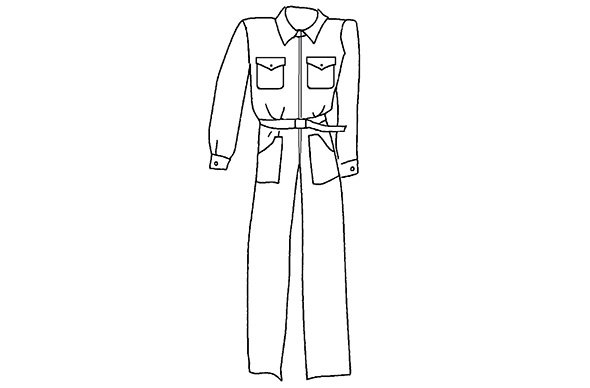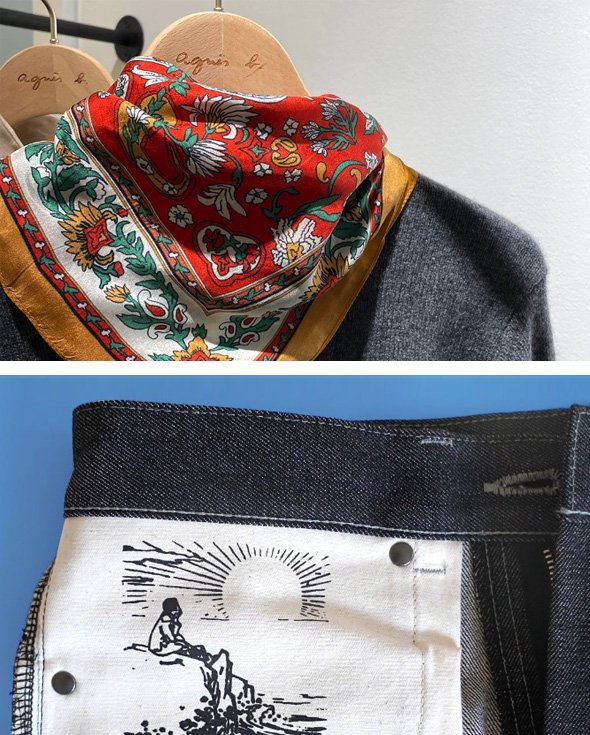Practical advice :
how to care of your clothes
This booklet has been designed to help you keep your agnès b. clothes looking as good as new, while taking care of our planet.
agnès b. creates timeless clothes that can be worn for a very long time.
In doing so, she is going against the trend of "disposable" fashion, which pushes us to over-consume clothes.
Beyond the style proposed by agnès, one of the secrets of the durability of a garment is good maintenance over the years!


The 11 golden rules for sustainable and
more environmentally friendly care of clothes
1 • Always check the washing instructions on the label of your garment.
2 • Only wash your clothes when necessary. Washing pollutes and consumes a lot of water and energy. Moreover, washing clothes made of synthetic materials, such as nylon, polyester or elastane, releases plastic micro-particles into the wastewater, which end up in the oceans.
3 • Wait until you have enough clothes to wash before starting your machine ,to avoid running it too often. However, avoid overloading the machine, so as not to pack the clothes. Always leave a space, approximately the width of a hand, between the top of the drum and the clothes.
4 • Wash at 30°C whenever possible : for most of our textiles, a low temperature wash of 30°C is sufficient. By washing at 30°C instead of 60°C, you can save over 60% of energy per wash. It also reduces limescale deposits and increases the life of your washing machine.
5 • Use detergents with an environmental label : You can also make your own detergent with natural products.
6 • Choose detergents without bleach or brightener for all coloured items.
7 • Avoid strongly scented detergents and softeners, as they may contain polluting detergents. They can also cause allergies when in contact with the skin.
8 • Use a low spin speed to prevent the garment from shrinking or pilling in the washing machine.
9 • Go for natural drying. Avoid using the tumble dryer, which is quite energy-intensive and distorts the fibres of the clothes.
10 • Only use professional cleaning if it is recommended on your garment label.
11 • Repair your clothes as soon as possible.
Applying all these principles will ensure that your clothes last longer.
This is what we are looking for at agnès b. :
designing clothes that last as long as possible!

Our care tips for each fabric
For all materials, we recommend that you refer to the care instructions on the garment label.
COTTON
Wash at 30°C if possible (the temperatures indicated on the label are maximum washing temperatures). Wash the garment inside out.
CREPON
To keep the best crepe aspect of your garment, let it dry on a hanger and spray the surface of the fabric, without direct contact with the iron shoe. Ironing will cancel out the crepe effect.

LEATHER
To preserve your leather collar, avoid contact with various cosmetics (gel, cream, perfume, lacquer, etc.)
To removea stain from your leather, quickly apply Terre de Sommières to absorb grease stains (except indelible ink stains) but take advice from a professional. Never use aggressive products intended for shoes and furniture.
JEAN
Denim colours can rub off on lighter materials. We therefore advise you to wash your jeans separately. Wash your jeans inside out and limit the number of washes as much as possible. Iron at 150°C except when the jeans contain elastane. In this case, it should not exceed 110°C to prevent the elastane from melting. Tumble drying is not recommended.
FLEECE, JERSEY
Wash and iron on the reverse side. Pull on the garment after spinning to restore its shape. Ideally, it should be dried on a hanger.

WOOL, ALPACA, MERINO, CASHMERE, KNITWEAR
Wash your garment after wearing it 2 or 3 times, the excess material will disappear and it will become softer. Wash it with a small amount of pH-neutral detergent, without fabric softener, at 30°C, by hand or in the machine (wool programme), with a spin cycle of 400 rpm. Shape the garment before drying it flat, away from direct light. Iron it with a soft iron. Avoid soaking and wringing. Always refer to the washing instructions on the garment label. If well cared for, your garment will become increasingly beautiful and soft.
LINEN
A linen garment may have some irregularities that give it its authenticity and uniqueness. We recommend that you wash it according to the instructions on the washing label.

POLYESTER
Washing clothes made of synthetic materials, such as polyester, releases plastic microparticles into the wastewater, which pollute the oceans. To limit this release of microparticles, start your machine with a full drum and avoid washing the clothes concerned above 30°C. Spin at a low speed and air dry.
POPELINE
Iron the poplin inside out to preserve its outer surface.
SILK
Wash your garment at a low temperature (maximum 30°C) with a mild detergent and a fabric softener, then put the garment on hang without spinning. Iron the wet garment.
CHEESE CLOTH
Dry gently, avoiding machine drying.
VELVET
Wash and iron the garment inside out.
VISCOSE
Wash inside out and use a gentle spin programme.
agnès b.'s secrets
THE SNAP CARDIGANS
-
By cutting up a sweatshirt to make a cardigan, agnès b. created the snap cardigan in 1979. Since then, it has travelled across the world !
Care instructions :
• We advise you to wash and iron all your fleece and jersey garments inside out.
• Pull on the garment after spinning to restore its shape.
• It is best to dry it on a hanger.
SCREEN PRINTED CLOTHING
-
Whether it is with the "artists' t-shirts" line, created in 1994, or the message t-shirts for women, men and children, agnès b. often uses screen printing.
Care instructions :
• Do not wash your T-shirts and screen-printed clothes at more than 30°C.
• Stretch them quickly after spinning.
• Iron them on the reverse side.
STRIPED SHIRTS
-
From the marinière she created in the fabric of a rugby polo shirt, which has remained in her collections ever since, to the ever-changing prints that appear on her clothes, agnès b. sees life in colours.
Care instructions :
• To ensure that the colours are preserved, do not soak your striped sailors or printed shirts after spinning.
• As with screen prints, lay them out at the end of the machine and iron them on the reverse side.

Cleaning symbols
Before cleaning or ironing a garment, always refer to the care symbols on the label sewn onto the side or back of the garment.
WASHING






TUMBLE DRY



IRONING





DRY CLEANING
Garments marked with one of these symbols must be cleaned exclusively at a dry cleaners. Each symbol indicates the type of treatment to be applied by the service provider. It has a contractual value, and if it is not respected, your dry cleaner will reimburse you in case of damage. It is therefore essential to keep the labels and purchase receipts for this type of clothing. For your information, we indicate the meaning of each of these symbols, which are difficult to understand by non-experts.



Still in doubt?
• clevercare.info
Tips and tricks

STAIN REMOVAL
Stain removal is the local removal of a stain that may not wash out or that you have made on a garment that needs to be professionally washed. It can be a thick stain (chocolate, paint, blood, food), or a liquid stain (fruit juice, wine, alcohol, coffee).
Here are a few tips to help you try stain removal yourself if you wish: avoid any heat action before stain removal (e.g. hot washing) as there is a risk of "cooking" the stain. Gently wash away the stain, by brushing it out if it is hard or dry, by scraping it with a round knife if it is viscous, by absorbing it with a white cotton cloth or a paper towel if it is liquid (place another piece of paper inside the garment and then tap it). In any case, do not rub the stain, to avoid embedding it in the fibre. Before pouring the stain remover, make sure that the fibre and the colours are well protected by the product used on a hidden part of the garment (hem for example).
When choosing a product, refer to the garment's composition label: never use bleach on wool, silk and viscose, polyamides, polyesters, acrylics and elastanes. Never use salt or white vinegar. Avoid using water on ink stains. In addition to commercially available stain removers, you can use carbonated water, ammonia, alcohol and white spirit.
Never pour the stain remover directly onto the stain: pour it onto a cloth or paper towel and tap lightly without rubbing, also place a cloth soaked in the product inside the garment. When the stain has been absorbed, dry it with a clean cloth. If a stain remains, steam the stain.
... then wash the garment according to the instructions on the label.

HANDWASH
Use a detergent that is specific to hand washing and, if necessary, specific to wool. Always wash in cold water without rubbing, do not soak, and rinse several times with clean water. Gently pull the garment back into shape, then lay it flat, avoiding direct contact with a major source of heat or light (sun, radiator, etc.)

MACHINE WASH
Carefully follow the care instructions on the label (temperature, spinning, use of bleach, etc.).
Wash light and dark colours separately. Turn dark-coloured clothes inside out and wash them with a minimum of detergent to keep them looking good. Empty pockets, unbutton and turn shirt collars inside out. Do not pack the laundry inside the machine. Incorrect dosage of detergent can lead to greying of the laundry: refer carefully to the dosage instructions on the detergent barrel. If you use the delayed wash option, prefer a powdered detergent.

DRYING
Use natural drying. Before tumble-drying a garment, check the care label to make sure it is allowed. Remember that even when it is allowed, tumble drying can cause felting and alter the proportions of the garment. It uses a lot of energy, which is a source of greenhouse gas emissions. For conventional drying, dry coloured garments inside out, with heavy garments folded so that they do not distort.
Some garments and fibres tend to distort, so stretch them gently before drying so that they regain their shape.

IRONING
The type of fabric usually determines the ironing temperature: refer to the garment care label to set your iron.
Generally speaking, ironing on the reverse side is preferable for all fabrics. It is also advisable to apply a damp cotton cloth between the garment and the iron, especially for fragile fabrics or those that are likely to shine.
Always iron prints on the reverse side. Ironing them on the right side will permanently damage them. Don't forget to clean your iron soleplate before it cools down completely, to avoid residues that could stain your clothes the next time you iron.
Frequently asked questions

HOW TO REMOVE A GREASE STAIN ?
Soak the stain for 24 hours with terre de Sommières or soak it with damp Marseille soap, then leave to dry and wash.
HOW TO REMOVE AN OIL STAIN ?
Apply dishwashing liquid to soak the fabric and then wash.
HOW TO REMOVE A FRESH BLOOD STAIN ?
Soak the bloodstain in cold water for 12 hours, then wash.
HOW TO REMOVE A DRIED BLOODSTAIN ?
Place the stained side on a paper towel and soak the back of the fabric with a mixture of cold water and hydrogen peroxide.
Repeat the operation several times and then wash.
HOW TO REMOVE A DRY RED WINE STAIN ?
Make a paste-like mixture on the wine stain with lemon and bicarbonate or white vinegar and bicarbonate.
Leave it to work, then add water and repeat the operation if necessary.
HOW TO WASH A DOWN JACKET ?
If the down jacket is washable: wash at 30°C (40°C max) with liquid detergent and 2 tennis balls.
If tumble drying is recommended: also add 2 tennis balls to optimise the loft.
HOW TO WASH A CAP ?
It all depends on the composition and assembly.
For a plain 100% cotton cap: wash at 30°C.
agnès b. philosophy
The quality of agnès b. is based on a long search for materials from the best weavers, mainly in France, Italy and Belgium. All our fabrics are exclusive. Comfort and touch are essential selection criteria. The prints are developed for agnès b., usually based on an idea or a drawing by the designer.
agnès b. has always supported the "Made in France" concept:
"We have been manufacturing in France since the brand was created in 1973, because in our country, we have know-how, workshops, and qualified people," Agnès emphasises.
Today, the company can no longer manufacture 100% of its collections in France: despite our support, some suppliers have had to transfer part or all of their production facilities abroad; others have disappeared without it always being possible to replace them in France. However, agnès b. still produces more than 30% of its garments in France, with the rest being made in Europe at most. The company also chooses to work with foreign suppliers in countries that have developed strong traditional know-how. In general, agnès b. carefully selects all of its suppliers based on precise social and environmental criteria, and has long-standing privileged relationships with most of them, considering them to be valuable partners.


